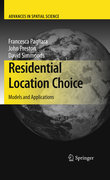
Residential location choice: models and applications
Pagliara, Francesca
Preston, John
Simmonds, David
The effective planning of residential location choices is one of the great challenges of contemporary societies and requires forecasting capabilities and the consideration of complex interdependencies which can only be handled by complex computer models. This book presents a range of approaches used to model residential locations within the context of developing land-use and transport models. These approaches illustrate the range of choices that modellers have tomake in order to represent residential choice behaviour. The models presentedin this book represent the state-of-the-art and are valuable both as key building blocks for general urban models, and as representative examples of complexity science. State-of-the-art models in residential location choice Peer-reviewed contributions Written by leading experts in the field INDICE: 1 Stated Preference Examination of Factors Influencing ResidentialAttraction.- 2 DRAM Residential Location and Land Use Model: Thirty Years of Development and Application.- 3 The DELTA Residential Location Model.- 4 The MUSSA II Land Use Auction Equilibrium Model.- 5 The Impact of Transport Policy on Residential Location.- 6 The Influence of Accessibility on Residential Location.- 7 Modeling Residential Location in UrbanSim.- 8 Household Behaviour in the Oregon2 Model.- 9 The Residential Choice Module in the Albatross and Ramblas Model Systems.- 10 A Microsimulation Model of Household Location.- 11 Conclusion.
- ISBN: 978-3-642-12787-8
- Editorial: Springer
- Encuadernacion: Cartoné
- Páginas: 250
- Fecha Publicación: 01/08/2010
- Nº Volúmenes: 1
- Idioma: Inglés
